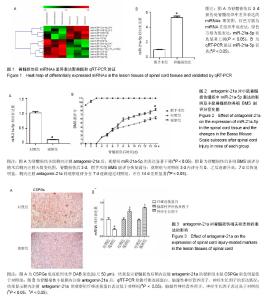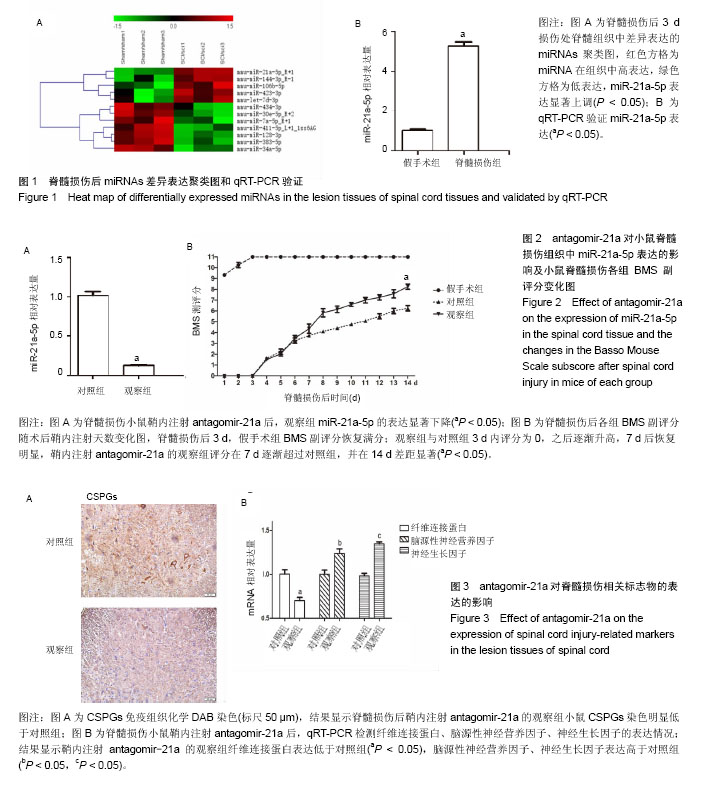| [1] Alilain WJ,Horn KP,Hu H,et al.Functional regeneration of respiratory pathways after spinal cord injury. Nature. 2011;475 (7355):196-200.[2] Cristante AF,Barros Filho TE,Marcon RM,et al.Therapeutic approaches for spinal cord injury. Clinics.2012;67(10):1219-1224.[3] Kawano H,Kimura-Kuroda J,Komuta Y,et al.Role of the lesion scar in the response to damage and repair of the central nervous system.Cell and tissue research.2012;349(1):169-180.[4] Watzlawick R,Howells DW,Schwab JM.Neuroprotection After Traumatic Brain Injury.JAMA neurology 2016;73(2):149-150.[5] Dong H,Lei J,Ding L,et al.MicroRNA: function, detection, and bioanalysis. Chemical reviews 2013;113(8):6207-6233.[6] Ameres SL,Zamore PD.Diversifying microRNA sequence and function. Nat Rev Mol Cell Biol.2013;14(8):475-488.[7] Ning B,Gao L,Liu RH,et al. microRNAs in spinal cord injury: potential roles and therapeutic implications. Int J Biol Sci. 2014; 10(9):997-1006.[8] Bhalala OG,Srikanth M,Kessler JA.The emerging roles of microRNAs in CNS injuries. Nature reviews Neurology. 2013; 9(6):328-339.[9] Zhu H,Luo H,Li Y,et al.MicroRNA-21 in scleroderma fibrosis and its function in TGF-beta-regulated fibrosis-related genes expression. J Clin Immunol.2013;33(6):1100-1109.[10] Abdel-Hamid NR,Mohammed EA,Abbas AH,et al.MicroRNA-21 Expression in Primary Breast Cancer Tissue Among Egyptian Female Patients and its Correlation with Chromosome 17 Aneusomy. Mol Diagn Ther. 2015;19(6):365-373.[11] Li Q,Zhang D,Wang Y,et al. MiR-21/Smad 7 signaling determines TGF-beta1-induced CAF formation. Sci Rep.2013;3:2038.[12] Huang Y,He Y,Li J.MicroRNA-21: a central regulator of fibrotic diseases via various targets. Curr Pharm Des. 2015;21(17): 2236-2242.[13] Krutzfeldt J,Rajewsky N,Braich R,et al. Silencing of microRNAs in vivo with 'antagomirs'. Nature 2005;438(7068):685-689.[14] Chu R,Wang J,Bi Y,et al. The kinetics of autophagy in the lung following acute spinal cord injury in rats. Spine J. 2018 Jan 17. pii: S1529-9430(18)30003-2.[15] Engesser-Cesar C,Anderson AJ,Basso DM,et al.Voluntary wheel running improves recovery from a moderate spinal cord injury.J Neurotrauma.2005;22(1):157-171.[16] Anderson MA,Burda JE,Ren Y,et al.Astrocyte scar formation aids central nervous system axon regeneration. Nature. 2016;532 (7598):195-200.[17] Shechter R, Raposo C, London A,et al.The glial scar-monocyte interplay: a pivotal resolution phase in spinal cord repair. PloS one.2011;6(12):e27969.[18] Zhu Y, Soderblom C, Krishnan V,et al. Hematogenous macrophage depletion reduces the fibrotic scar and increases axonal growth after spinal cord injury. Neurobiol Dis. 2015;74: 114-125.[19] Hara M,Kobayakawa K,Ohkawa Y,et al.Interaction of reactive astrocytes with type I collagen induces astrocytic scar formation through the integrin-N-cadherin pathway after spinal cord injury. Nature medicine.2017;23(7):818-828.[20] Yiu G,He Z.Glial inhibition of CNS axon regeneration.Nature reviews Neuroscience 2006;7(8):617-627.[21] Klapka N,Muller HW.Collagen matrix in spinal cord injury. J Neurotrauma. 2006;23(3-4):422-435.[22] Ohtake Y,Smith GM,Li S. Reactive astrocyte scar and axon regeneration: suppressor or facilitator? Neural Regen Res. 2016;11(7):1050-1051.[23] Yu YM,Gibbs KM,Davila J,et al.MicroRNA miR-133b is essential for functional recovery after spinal cord injury in adult zebrafish. Eur J Neurosci. 2011;33(9):1587-1597.[24] Jee MK,Jung JS,Choi JI,et al.MicroRNA 486 is a potentially novel target for the treatment of spinal cord injury. Brain. 2012;135(Pt4): 1237-1252.[25] Maurer LM,Ma W,Mosher DF.Dynamic structure of plasma fibronectin. Crit Rev Biochem Mol Biol. 2015;51(4):213-227.[26] King VR,Alovskaya A,Wei DY,et al.The use of injectable forms of fibrin and fibronectin to support axonal ingrowth after spinal cord injury.Biomaterials.2010;31(15):4447-4456.[27] Kim M,Kim KH,Song SU,et al.Transplantation of human bone marrow-derived clonal mesenchymal stem cells reduces fibrotic scar formation in a rat spinal cord injury model. J Tissue Eng Regen Med. 2017 Jan 23.[28] Bothwell M. NGF, BDNF, NT3, and NT4. Handb Exp Pharmacol. 2014;220:3-15.[29] Simeoli R,Montague K,Jones HR,et al.Exosomal cargo including microRNA regulates sensory neuron to macrophage communication after nerve trauma. Nature communications. 2017;8(1):1778.[30] Omura T,Omura K,Tedeschi A,et al.Robust Axonal Regeneration Occurs in the Injured CAST/Ei Mouse CNS. Neuron. 2015;86(5): 1215-1227.[31] Wei F, Liu D, Feng C,et al. microRNA-21 mediates stretch-induced osteogenic differentiation in human periodontal ligament stem cells. Stem Cells Dev. 2015;24(3):312-219. |

